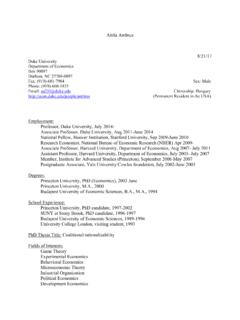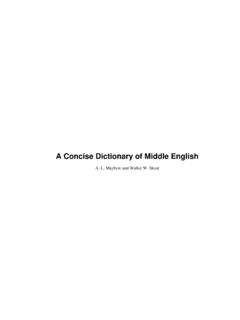Transcription of Joseph M. Williams - Duke University
1 Joseph M. Williams Toward Clarity and Grace With two chapters coauthored by Gregory G. Colomb The University of Chicago Press Chicago and London Joseph M. Williams is professor in the departments of English lan guage and literature, and linguistics and in the College at the University of Chicago. Gregory G. Colomb is associate professor in the School of Literature, Communication, and Culture and director of writing programs at the Georgia Institute of Te chnology. The University of Chicago Press, Chicago 60637 The University of Chicago Press, Ltd., London Published by arrangement with Scott, Foresman and Company Copyright 1990 by Joseph M. Williams Copyright 1989, 1985, 1981 by Scott, Foresman and Company All rights reserved. Published 1990 Printed in the United States of America 99 98 97 96 95 94 93 92 91 90 5 4 3 2 1 @l The paper used in this publication meets the minimum requirements of the American National Standard for Information Sciences-Permanence of Paper for Printed Library Materials, ANSI Library of Congress Cataloging in Publication Data Williams , Joseph M.
2 Style: toward clarity and grace I Joseph M. Williams . p. cm. - (Chicago guides to writing, editing, and publishing) Includes bibliographical references. ISBN 0-226-89914-4 (alk. paper) 1. English, language-Style. I. Title. II. Series. 1990 808' .042-dc20 90-34828 CIP , , , , , Contents Preface ix 1 Causes 1 2 Clarity 17 3 Cohesion 45 4 Emphasis 67 5 Coherence I 81 With Gregory G. Colomb 6 Coherence II 97 With Gregory G. Colomb 7 Concision 115 8 Length 135 9 Elegance 153 10 Usage 169 Notes 199 Acknowledgments 201 Index 203 Preface This book originated as Style, first published as a textbook by Scott Foresman in 1981 and then in two more editions in 1985 and 1989. I wrote it for four reasons. First, the standard books on style don't go much beyond high mindedness.
3 They are all for accuracy, brevity, clarity,. and so forth, but beyond offering good and bad examples, none of them explains how to achieve those ends. Second, the standard books gesture toward audiences, but none of them explains in detail how a writer must anticipate what readers look for as they make their way through complex, usually unfamiliar material. Third, the standard books seem wholly innocent of recent work done in the cognitive sciences, much of it centrally relevant to understanding the problems that readers have to solve every time they begin a new sentence. And fourth, the standard handbooks mainly address belletristic or journalistic writing, None of them reflects sustained experience working with writers in areas other than literature or journalism.
4 In Style, I tried to integrate research into the ways that readers read with my experience working with professional writing in a variety of fields, in order to create a system of principles that would simultaneously diagnose the quality of writing and, if nec- essary, suggest ways to Improve It. In 1988 the University of Chicago Press inquired whether Style might be revised for use outside a classroom. Since many readers had reported learning a good deal from reading Style on their own, a new version specifically for such an audience seemed to be a good idea. The objective of this book remains the same: to explain how writers can improve the style and the structure of their reports, analyses, articles, memoranda, proposals, monographs, books.
5 In Chapter 5 and 6, Gregory Colomb and I go beyond matters of sentence style to discuss larger matters of form and organization . IX x Preface We do not directly address the kind of prose that some might call "imaginative" or "expressive." At some level, of course, all writ ers express feelings, all writers imagine, no sensible writer delib erately avoids turning a graceful phrase, no matter how banal the subject. Aesthetic pleasure and clarity are by no means mutually exclusive; indeed, they are usually part of the same experience. But the object of our attention is writing whose success we mea sure not primarily by the pleasure we derive from it, but by how well it does a job of work. If it also gives us a tingle of pleasure, so much the better.
6 Except for a page or two at the end of Chapter 6, we discuss neither how to prepare for nor how to produce a first draft. There is folk wisdom about what we ought to do brainstorm, take notes, make a scratch outline, analyze objectives, define au diences; then as we draft, keep on writing, don't stop to revise minute details of punctuation, spelling, etc., let the act of writing generate ideas. When we create a first draft, we should be most concerned with getting onto the page something that reflects what we had in mind when we began to write and, if we are lucky, something new that we didn't. But once we have made clear to ourselves what ideas, points, and arguments might be available, we then have to reshape that first draft to provide what our readers need.
7 We write a first draft for ourselves; the drafts thereafter increasingly for the reader. That is the central objective of this book: to show how a writer quickly and efficiently transforms a rough first draft into a ver sion crafted for the reader. Two More Objectives We set for ourselves two more objectives, because seeming clarity in professional writing is a matter that depends on more than merely a writer's level of skill. First, mature writers can write badly for different reasons confusion about a subject, in sufficient time to revise, carelessness, entrenched bad habits, sheer incompetence. But to casual readers, these causes may re sult in what seems to be the same kind of tangled prose. Those who experience problems with their writing have to understand that they must approach different causes of bad writing in differ ent ways.
8 That understanding is even more crucial to those who have to deal with the writing of others. So we explain how bad Preface Xl writing results from different causes and how writers can diag nose different problems and overcome them. There is a second general objective: It is important for every one those who write professional prose and those who have to read it to understand not only its social origins but its social consequences. When a piece of writing confuses us, we often as sume that we are not up to its demands. Difficult a passage may be, but its complexity is often more seeming than substantial. We have seen hundreds of students experience relief from doubts about their own competence when they realize that if they are unable to understand an article or monograph, it is not nec essarily because they are incompetent, but because its author couldn't write clearly.
9 That liberation is a valuable experience. Whether we are readers or writers, teachers or editors, all of us in professional communities must understand three things about complex writing: it may precisely reflect complex ideas, it may gratuitously complicate complex ideas, it may gratuitously complicate simple ideas. Here is an example of the second kind of complexity: Similarities may develop in the social organization of societies at similar levels of economic development because there are "im peratives" built into the socio-technical system they adopt which drive them to similar responses to common problems. This model, therefore, places great emphasis on the level of economic development of nations to account for movement towards com mon forms of social organization.
10 Alternatively, convergence may result from simple borrowing, so that a model of the diffusion of innovation becomes appropriate. Where such borrowing occurs levels of development may be less relevant than integration in net works of influence through which ideas and social forms are dif fused. Economic development may, of course, set limits on the capacity of a nation to institute systems available to be copied, and the propensities to copy may enable nations to install con vergent patterns more rapidly than one would have predicted from knowledge of their level of economic development. I This means, Societies at similar levels of economic development may converge because "imperatives" in their sociotechnical system cause them to respond to similar problems in similar ways.















